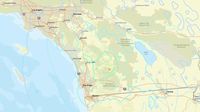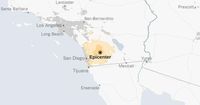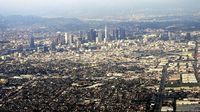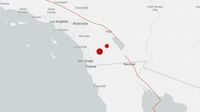A magnitude 5.2 earthquake struck Southern California on Monday, April 14, 2025, around 10:08 AM local time, shaking the region near the mountainous town of Julian, located east of San Diego. The tremor's epicenter was recorded approximately 4 kilometers south of Julian, according to the United States Geological Survey (USGS). The earthquake was felt across several counties, including Los Angeles, and even reached the Mexican border city of Tijuana.
The quake occurred at a depth of about 13 kilometers and was followed by at least seven aftershocks within the first half hour. While initial reports indicated a stronger magnitude of 6, the USGS later confirmed the magnitude as 5.2. As of now, there have been no reports of injuries or significant damage, and local authorities are working with emergency services to assess the situation.
Residents in the area expressed their shock at the sudden tremor. Paul Nelson, owner of the Eagle Mining Co., a historic gold mine turned tourist attraction in Julian, described the experience as "very scary," adding, "I thought the windows were going to explode." He noted that while the tunnels of the old mine remained intact, the shelves in the gift shop shook violently during the quake.
Another resident from Carlsbad, a coastal city approximately 100 kilometers from the epicenter, reported that chandeliers in his home shook, and lights swayed in all directions. "I was sitting in my kitchen, and everything was moving," he recounted. Such reactions highlight the earthquake's noticeable impact, even at considerable distances from the epicenter.
The California Geological Survey has stated that the state is prone to earthquakes due to its location along the Pacific Ring of Fire, an area known for its high seismic activity. This particular quake is a reminder of the region's vulnerability to such natural events. In fact, experts from the USGS estimate that nearly 75% of the United States is at risk for damaging earthquakes in the future.
In the immediate aftermath of the earthquake, local emergency services were on standby to respond to any potential issues. The San Diego County Sheriff’s Office reported no initial damage or injuries, which is a relief given the earthquake's magnitude and the population density in the area.
Seismologists emphasize the importance of preparedness in earthquake-prone regions. They recommend that residents have emergency kits ready and be familiar with safety protocols, such as the “Drop, Cover, and Hold On” method during tremors. This is crucial not only for personal safety but also for minimizing panic during such events.
As aftershocks can continue for days, weeks, or even longer following a significant quake, residents are advised to stay alert and prepared for further seismic activity. The USGS has a system in place to monitor these aftershocks and provide updates to the public.
Interestingly, the Richter scale, once the standard for measuring earthquakes, has been largely replaced by the moment magnitude scale, which offers a more accurate assessment of an earthquake's size, especially for larger quakes. This change reflects advancements in seismology and the need for more precise data in understanding seismic events.
In addition to the Julian earthquake, several smaller quakes were recorded across California on the same day. For instance, a magnitude 2.6 earthquake occurred 20 kilometers northeast of Morgan Hill, while a magnitude 2.2 quake was noted near Big Bear Lake. These smaller tremors serve as a reminder of the ongoing seismic activity in the region.
As the dust settles from the recent earthquake, the focus now shifts to assessing any potential damage and ensuring the safety of residents. Emergency services and local authorities continue to work diligently to monitor the situation and provide updates to the community.
In conclusion, the magnitude 5.2 earthquake that struck Southern California serves as a stark reminder of the region's seismic risks. With no reports of injuries or significant damage, the community can breathe a sigh of relief, but the need for preparedness remains as relevant as ever.








